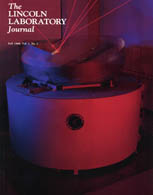Publications
Volume 1, Number 2
 |
|
Lightweight Mirror Structures for Mechanical Beam Steering Defense applications of space-borne laser radar require a sensor that can point to a large number of targets - in rapid succession and over a wide field of regard. By using a full-aperture, mechanically steered flat mirror, the requirements for high-acceleration beam steering can be met. Three alternative mirror structures were designed and their performance was evaluated through computer simulation. The mirror structures were (1) a thin glass sandwich coupled to a deep backup structure, (2) a full-depth beryllium sandwich, and (3) a full-depth graphite/epoxy sandwich. Unlike existing large steering mirrors, these mirrors can survive angular accelerations as high as 1000 rad/s2 during steering. yet still limit residual vibration amplitudes after steering to lambda/20 rms at 1O.6 μm. All three designs can use existing fabrication technologies to meet performance goals. An Algorithm for the Evaluation of Radar Propagation in the Spherical Earth Diffraction Region We develop an efficient method for computing the Airy function and apply this method to the problem of calculating the radar propagation factor for diffraction around a smooth sphere. Even for high-altitude antennas, our calculations give accurate results well into the visible region, and thus extend the useful range of the Spherical Earth with Knife Edges (SERE) radar propagation model. Speech Processing Based on a Sinusoidal Model Using a sinusoidal model of speech, an analysis/synthesis technique has been developed that characterizes speech in terms of the amplitudes, frequencies, and phases of the component sine waves. These parameters can be estimated by applying a simple peak-picking algorithm to a short-time Fourier transform (STFT) of the input speech. Rapid changes in the highly resolved spectral components are tracked by using a frequency-matching algorithm and the concept of "birth" and "death" of the underlying sine waves. For a given frequency track, a cubic phase function is applied to a sine-wave generator, whose output is amplitude-modulated and added to the sine waves generated for the other frequency tracks, and this sum is the synthetic speech output. The resulting waveform preserves the general waveform shape and is essentially indistinguishable from the original speech. Furthermore, in the presence of noise the perceptual characteristics of the speech and the noise are maintained. It was also found that high-quality reproduction was obtained for a large class of inputs: two overlapping, superposed speech waveforms; music waveforms; speech in musical backgrounds; and certain marine biologic sounds. The analysis/synthesis system has become the basis for new approaches to such diverse applications as multirate coding for secure communications, time-scale and pitch-scale algorithms for speech transformations, and phase dispersion for the enhancement of AM radio broadcasts. Moreover, the technology behind the applications has been successfully transferred to private industry for commercial development. Intersatellite Optical Heterodyne Communication Systems High-capacity intersatellite communication crosslinks will allow more efficient and reliable operation of military and commercial satellite systems. High-speed optical crosslinks can serve as a key building element of an interconnected space-based communication system for military applications. A network such as this would provide immediate communication among satellites, eliminating the need for ground-based relay stations and expensive worldwide ground tracking networks, which would greatly improve the efficacy and reduce the vulnerability of existing satellite systems. Crosslinks can also provide connectivity for commercial global satellite communication systems and for deep-space applications. Optical heterodyne communication systems using semiconductor lasers offer small-aperture, modest-weight, low-power, point-to-point crosslink packages, characteristics that are suitable for the envisioned applications. System research and development performed at Lincoln Laboratory permits the implementation of an efficient optical crosslink based on readily available, state-of-the-art devices and technology. In Situ Technologies for Semiconductor Patterning In situ processing methods simplify fabrication of semiconductor devices and, furthermore, eliminate exposure of surfaces to air, liquids, or human operators. The principal methods for in situ patterning of semiconductors are reviewed. Two methods, laser-direct writing and excimer-laser projection, appear to be promising candidates for advanced semiconductor fabrication. Ion-beam techniques will have important special applications. Analysis of Satellite Drag The use of thermospheric density models for calculation of the drag force on satellites is evaluated. These models are essential for precision orbit determination and for geophysical research. Drag data plays an important role in understanding the thermosphere and can contribute in a unique way to the monitoring of the next solar cycle. Nevertheless, determining the atmospheric drag on a satellite presents several problems. The current suite of thermospheric models is described and a subset of these models is analyzed quantitatively. These models are evaluated by using precision tracking data on three spherical satellites. At the lowest altitude, 270 km, all models performed equally well, but at the higher altitudes, the models did not all perform as well. The tracking data also permits an evaluation of the atmospheric indexes currently used in thermospheric models, and of the precipitation index, which is not yet included in the models. Significant correlation is found between the data and the precipitation index. Coherent Laser Beam Addition: An Application of Binary-Optics Technology Coherent laser beam addition offers the potential for extremely bright optical sources by combining the power from many individual lasers. Binary-optical elements—surface-relief structures etched into optical substrates by integrated-circuit techniques—have been successfully employed in three optical beam addition systems. The techniques can produce diffraction-limited laser sources from large-scale two-dimensional laser arrays. Future electro-optic systems, ranging from communications to space surveillance, can benefit from the new high-power laser sources made possible by coherent laser beam addition. |
|